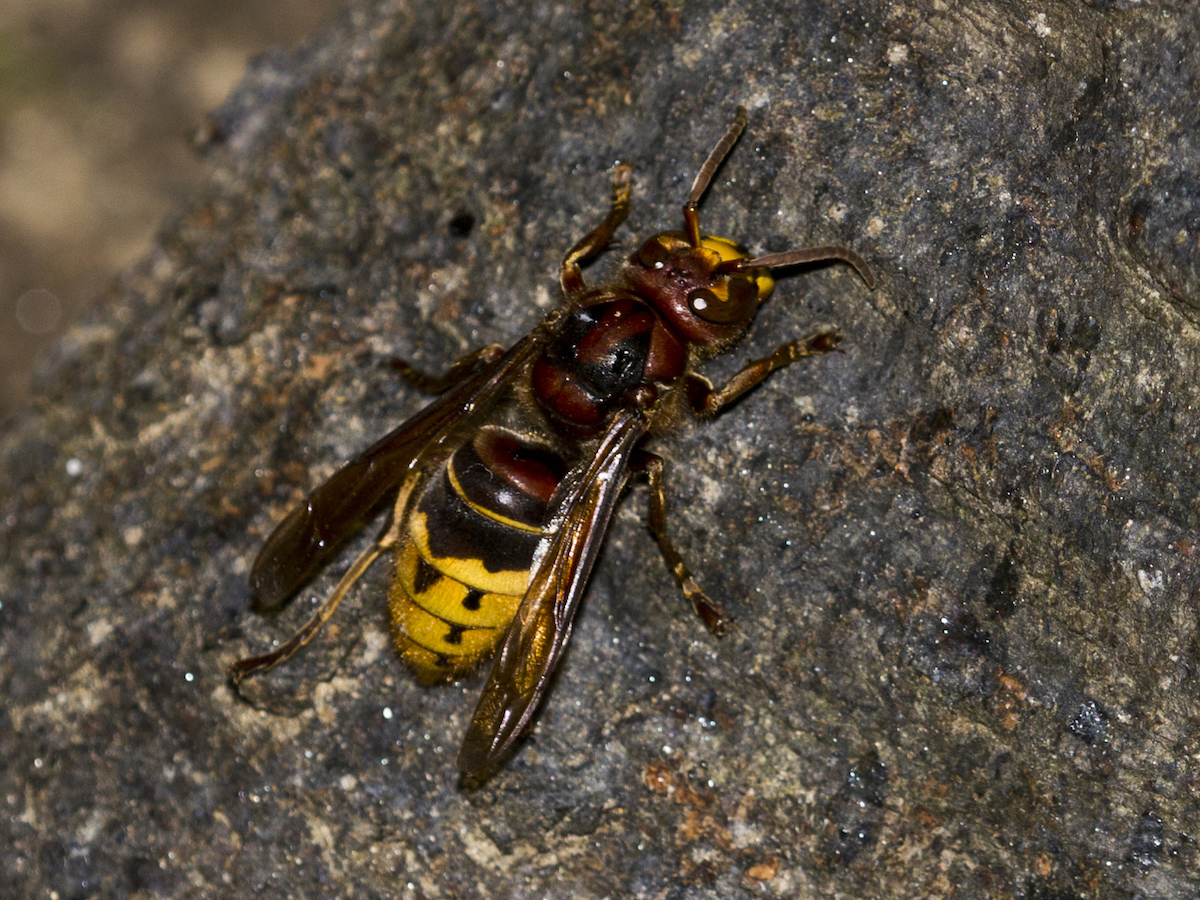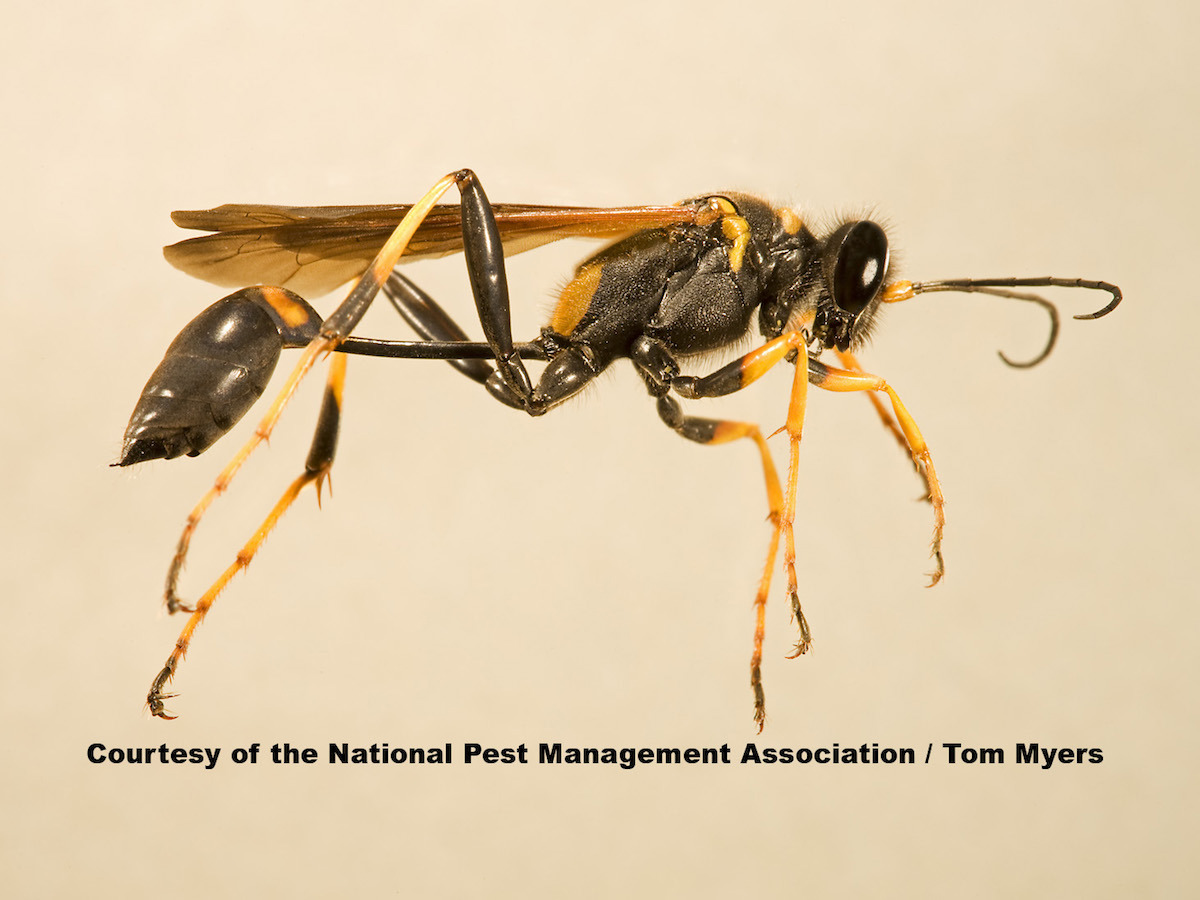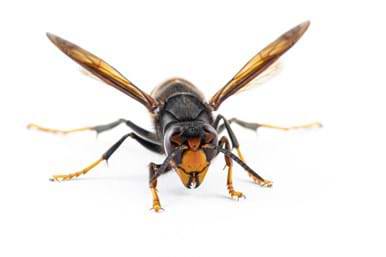Northern Giant Hornet Vespa mandarinia

Northern Giant Hornet Identification
Color: Light orange head with orange and brown/black striped body
Size: 1 1/2 – 2” (35-50 mm)
Legs: 6
Antennae: Yes
Shape: Long, robust
Region: Native to East and South Asia, but recently sighted in the Pacific Northwestern U.S.
What are Northern Giant Hornets?
Northern giant hornets, often referred to as Asian giant hornets, are the largest known hornet species in the world. They got their “Asian giant hornet” nickname because they are typically found in China, Japan and several other Asian countries. The first U.S. sighting of the species occurred in Washington in December 2019. This hornet species prefers to live in low forests and mountains, while avoiding high-altitude climates and plains. Northern giant hornets primarily feed on other insects and are known to attack bee nests and destroy their colonies. Sometimes referred to as “murder hornets” by media outlets, they are reported to kill as many as 50 people a year in Japan, repeatedly stinging targets when their colony is threatened.
Northern Giant Hornet Size
The northern giant hornet is the largest of any hornet species in the world. The size of a northern giant hornet usually varies between 1 ½ to 2 inches in length. Queens can exceed 2 inches in length while workers are typically between 1.4 and 1.6 inches. They have a wingspan around 3 inches and a stinger measuring about a ¼ inch long. These hornets have large orange-yellow heads with prominent eyes, orange and black stripes extending down their bodies, as well as distinct sharp mandibles. These hornets are not confirmed to be established in the U.S. and people can mistake bald-faced hornets or European hornets for them.
The northern giant hornet is the largest of any hornet species in the world. The size of a northern giant hornet usually varies between 1 ½ to 2 inches in length. Queens can exceed 2 inches in length while workers are typically between 1.4 and 1.6 inches. They have a wingspan around 3 inches and a stinger measuring about a ¼ inch long. These hornets have large orange-yellow heads with prominent eyes, orange and black stripes extending down their bodies, as well as distinct sharp mandibles. These hornets are not confirmed to be established in the U.S. and people can mistake bald-faced hornets or European hornets for them.
The stinger of a northern giant hornet is typically about a ¼ inch (6 mm) in length, longer and more dangerous than that of most other stinging insects. In fact, their stingers are long enough to puncture a beekeeping suit. Such stings are painful and contain neurotoxins. The sting from a northern giant hornet can be more severe to humans compared to a honey bee because they can inject up to 28 times more venom in a single sting. However, unless someone is highly allergic to stinging insects or sensitive, it would take many stings during one event for the situation to become life threatening and is an incredibly rare occurrence. It is estimated that only about one out of one million people per year worldwide die purely from an overload of venom of stinging insects without any other underlying sensitivity or allergic reactions. However, other stinging insect species already established in the U.S. send more than 500,000 people to the emergency room each year.
The life cycle of Northern giant hornets typically begins in spring when the queen emerges from hibernation and searches for a location to build her nest. Colonies live in subterranean nests, meaning they are located underground. Northern giant hornets are social pests, living in nests comprised of one queen and many workers, which typically fly about 1 mile, but can fly up to about 5 miles from their hive to find food. They are efficient predators, hunting medium- to large-sized insects such as other hornet species, large beetles and mantises. However, these pests are especially known for feeding on honey bees.
Northern giant hornets typically attack honeybee hives from late summer to early fall. Upon finding a hive, the hornets will use their large mandibles to decapitate the bees. A single northern giant hornet can kill as many as 40 honeybees per minute and just a small group of hornets can destroy an entire colony’s population of workers within 90 minutes. These hornets are much larger than honey bees and are armored, rendering honey bee stings virtually harmless. Once they have killed the honey bees, northern giant hornets will occupy the nest and feed on the colony’s pupae and larvae, also feeding it to their own young. If these stinging insects become established in the U.S. and spread, they may significantly impact local honey bee populations.
Northern giant hornets typically live underground in subterranean nests, making colonies difficult to locate. Usually, the hornets will create nests by digging into the ground, occupying pre-existing tunnels dug by other animals such as rodents, or seeking out spaces near rotted tree roots.
Northern giant hornets typically do not attack humans unprompted, primarily stinging only when they feel their nest is being threatened. This species can inflict a painful sting containing neurotoxins, which can be fatal to people if large numbers of stings are received, especially if they are allergic. When threatened, these hornets will attack their target in large groups, potentially subjecting a victim to a high number of stings. Northern giant hornet stings can be extremely painful and can result in organ failure when a victim suffers many stings at once.
As of late 2019, Washington is the only U.S state with official northern giant hornet sightings. Due to their similar appearances, bald-faced hornets and European hornets can be mistaken for northern giant hornets. Regardless of the species, if you discover or suspect a stinging insect infestation, contact a licensed pest control professional to effectively handle the problem. Northern giant hornet nest removal is not a “do-it-yourself” job, as stinging insects send more than 500,000 people to the emergency room every year.
You can find a certified professional near you with the helpful zip code search below.




